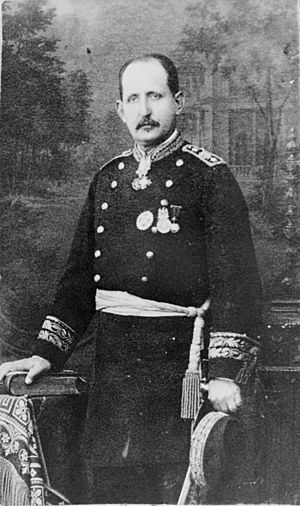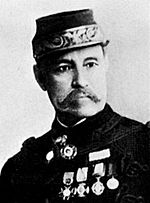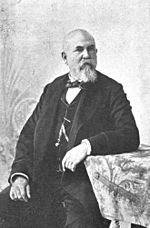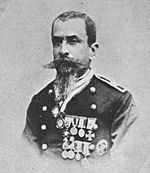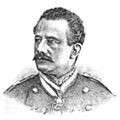Cajemé facts for kids
Quick facts for kids
Cajemé (José María Bonifacio Leyva Pérez)
|
|
|---|---|

Cajemé in April 1887, while under arrest
|
|
| Born | 1835 Pesiou (now Hermosillo, Sonora, México) |
| Died | 1887 Tres Cruces de Chumampaco |
| Allegiance | Yaquis |
| Years of service | 1854-1887 |
| Rank | Captain in the Mexican Army |
| Battles/wars | Franco-Mexican War War of Reform Yaqui Wars |
Cajemé (pronounced Kah-heh-EH-meh) or Kahe'eme is a Yaqui word meaning "one who does not stop to drink [water]". He was born José María Bonifacio Leyba Pérez in 1835. Cajemé was a very important Yaqui military leader from the Mexican state of Sonora. He lived from 1835 to 1887. The name Kahe'eme was originally a family name.
Contents
Biography
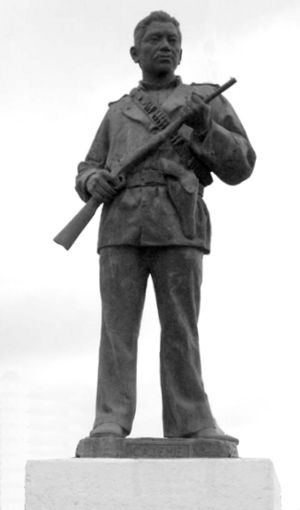
José María Bonifacio Leyba Perez was born on May 14, 1835. His birthplace was Pesiou, a Yaqui name for a place now called Hermosillo, in Sonora. His father was Fernando Leiva and his mother was Juana María Peres.
California Gold Rush
When José was about 14 years old, he went with his father and many other Yaqui people to California. This was during the 1849 "Gold Rush". They returned to Sonora about two years later. During this time, José likely learned to speak English. He also got his first experience with difficult situations.
After returning, José went to a special private school in Guaymas. This was one of the few schools in Sonora back then. There, he learned to read and write Spanish.
Military Experience
José María Leiva first experienced military battle in 1854. He was serving with the "Urbanos," a local militia in Guaymas. This group was led by his teacher, Cayetano Navarro. They fought against a group led by Count Gaston de Raousset-Boulbon. The Count wanted to take control of Sonora.
On July 13, 1854, the battle began in Guaymas. The Count's forces had over 350 French, German, and Chilean fighters. After about two hours of fighting, the Mexican forces, led by General José María Yáñez, won. The Count surrendered his army. José was 18 years old at this time.
Later, José joined the regular Mexican army. He served under General Ramón Corona. Because of his past military experience and his ability to speak three languages, José became an aide to General Corona. He fought in the Reform War and against the French forces of Emperor Maximilian. General Corona was the one who accepted Emperor Maximilian's surrender in 1867.
Eventually, José served under Ignacio L. Pesqueira, who was the governor of Sonora. Pesqueira saw that José was a skilled and educated officer. He made José a captain in the cavalry.
Appointment as Alcalde Mayor
In 1872, because of his excellent service in the Mexican military, José was given an important job. He was appointed ""Alcalde Mayor"" of the Yaqui people by Governor Ignacio Pesqueira. An Alcalde Mayor was like a main mayor or leader.
Governor Pesqueira expected José to help bring peace to the Yaqui people. But José did something different. He united the eight Yaqui pueblos (villages) into a small, independent area. He announced that he would not recognize the Mexican government unless his people could govern themselves. José became a leader who wanted to improve his people's lives.
He brought back old Yaqui ways of governing. He also set up a system of taxation and controlled trade. For example, he taxed ships that traded in the Yaqui River. These economic changes helped the Yaqui get weapons and supplies. They also helped them develop farming, raising animals, and fishing. All of this was to help and defend the Yaqui nation against those who wanted to take their traditional lands.
Cajemé's Rebellion Against Mexican Authority
The Mexican government did not like the idea of the Yaqui governing themselves. Because of this, José had to lead the Yaqui in a war against the Mexican government. This war was fought against those who wanted to control and take the traditional Yaqui lands. The war lasted a long time because the Yaqui were skilled fighters under José's leadership. It was a very harsh war with many terrible events on both sides.
One important battle was the Battle of Capetamaya on October 15, 1882. Cajemé was meeting with the Mayo near Capetamaya in Sonora. Colonel Augustine Ortiz, a local landowner and brother of the governor, attacked the meeting with Mexican Army soldiers. Cajemé was wounded, and his forces were scattered. Many people thought this attack was unnecessary, and it led to the governor being removed from his position.
Cajemé was known for singing in Spanish at the front of his troops. He would ride his horse, singing a song about bravery and not fearing the Mexican army. He would have a few men with him, followed by more on horseback, and then infantry soldiers.
In 1885, one of Cajemé's own lieutenants, Loreto Molina, tried to kill him. Molina, with support from Mexican authorities, planned to assassinate Cajemé at his home. But Cajemé was not there. Molina's men looted and burned Cajemé's house.
After Molina failed, the Mexican Government sent a large force of 3,600 soldiers to occupy Yaqui territory. General Angel Martinez took control of these forces.
Under General Martinez, the Mexican forces moved into the Yaqui River villages. They used new weapons like mitrailleuse (early machine guns) and howitzers. General Martinez directed the occupation from his headquarters. General Bonifacio Topete tried to attack a strong fort built by the Yaqui near Vícam, called "El Añil." This fort had fences, walls, and a moat. Even with cannons, Topete's forces were defeated. After this, Cajemé ordered his forces to build more defenses and fight from trenches. In April 1886, the Mexican forces took the Yaqui town of Cócorit. On May 5, 1886, a major attack began at El Añil. By May 16, the Mexican army destroyed the fort, which was a big defeat for the Yaquis.
Betrayal
Cajemé was eventually betrayed by a Yaqui woman who supported those against resisting Mexican authority. He was captured on April 13, 1887, while visiting family in San José de Guaymas. General Angel Martinez kept Cajemé under house arrest. He was treated with respect as a defeated leader.
Ramón Corral, who later became Vice-Governor and then Governor of Sonora, interviewed Cajemé extensively. During this time, Cajemé's famous saying was recorded: "Before was before and now is now. Before we were enemies and we fought; now everything is concluded and all can be friends." Several photos were taken of Cajemé during his arrest. He was shown in traditional Mexican farmer clothes and in a military jacket. In both photos, he held a Carbine and a Colt revolver.
Events Following Cajemé's Death
On May 20, 1887, Anastasio Cuca, Cajemé's second-in-command, was captured. He was later executed. After this, Juan Maldonado Waswechia, also known as Tetabiate (meaning "Rolling Stone" in Yaqui), took over leading the fight against the Mexican forces in June 1887.
By this time, the Yaqui population along the Yaqui River had suffered greatly. Many Yaqui people were forced to work as laborers in the Yucatán Peninsula, where thousands died. Many more were killed or fled to other Mexican states. A good number of Yaqui people escaped to Southern Arizona, which was part of their traditional land. Their descendants live there today.
José María Leyba's Families
José María Leyba was married at least two times. His first wife was María Jesus Salgado Ramires. They had two children: a son, Sotero Emiliano Leiva Salgado (born 1863), and a daughter, Victoria Leiva Salgado (born 1866). Emiliano was known to fight alongside his father. Victoria later married William E. Godman, an American businessman. With her husband's help, Victoria, her mother María, and her brother Emiliano were able to escape the persecution of the Yaqui people in Sonora. They eventually moved to the United States in 1900.
José's second marriage was to María Jesús Maccima Matus Morales in 1878. They had at least two children, a son and a daughter. This family's home was the one that Loreto Molina and his followers burned in 1885.
Municipality of Cajeme
After Cajemé's death, the Yaqui struggled to keep their traditional lands. By 1890, the Mexican government gave land and water rights along the Yaqui River to a company. This company started building canals for farming.
Later, the Richardson Construction Company bought the land rights in 1906. They sold land to settlers and got special rights to the Yaqui River's water. A train station was built nearby by the Southern Pacific Railroad and was named Cajeme.
The town of Cajeme was first part of another municipality. But on September 28, 1927, it became its own municipal seat. On July 28, 1928, the city was renamed Ciudad Obregón. In 1937, it was decided that Cajeme would be the name of the Municipality, and Ciudad Obregón would be its main city.
Today, the Municipality of Cajeme remembers Cajemé's death every year. They hold gatherings and speeches to highlight the battles where Cajemé led his people against the Mexican Government, fighting for their independence.
Images for kids
See also
 In Spanish: José María Leyva (Cajemé) para niños
In Spanish: José María Leyva (Cajemé) para niños


